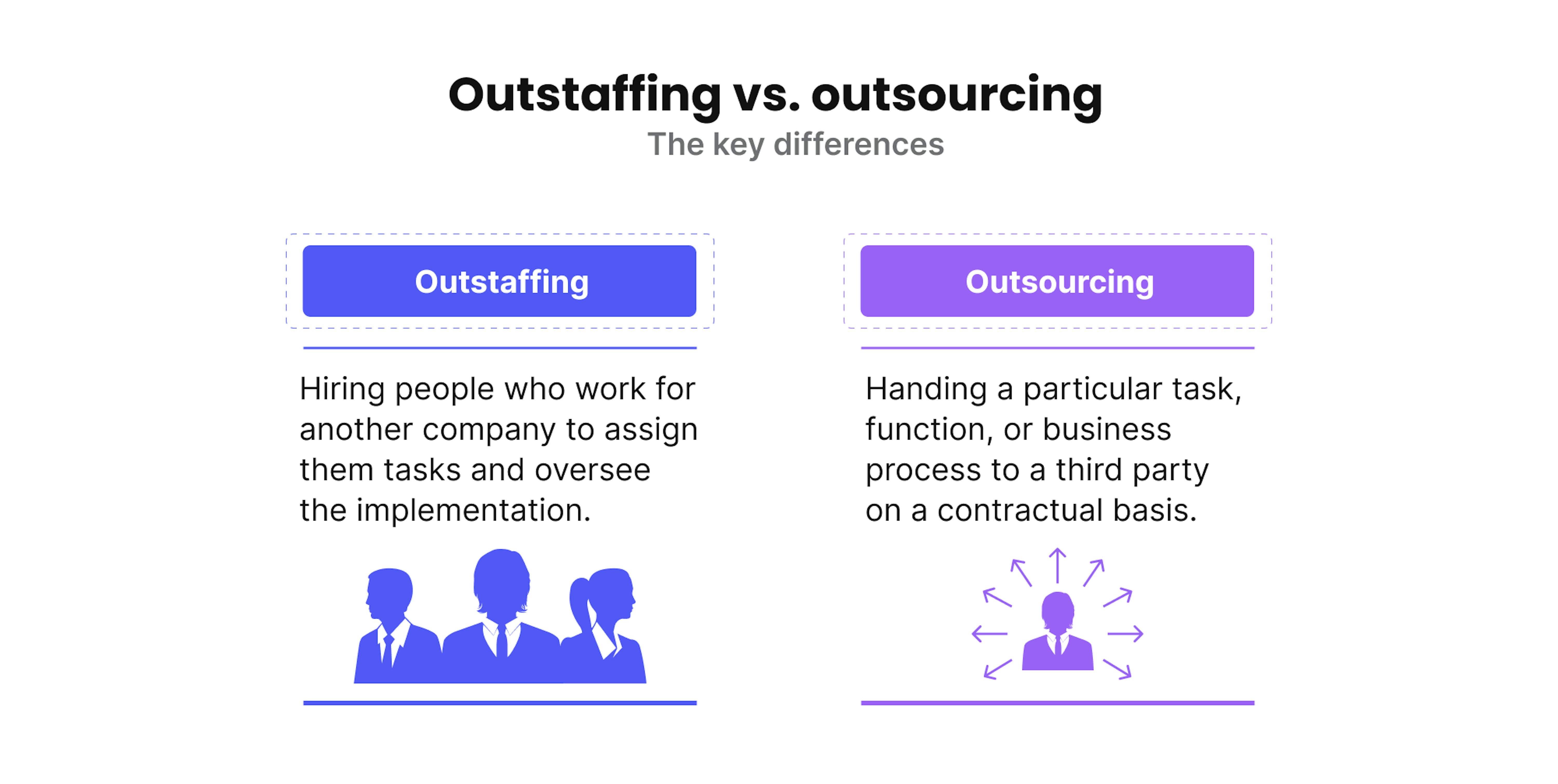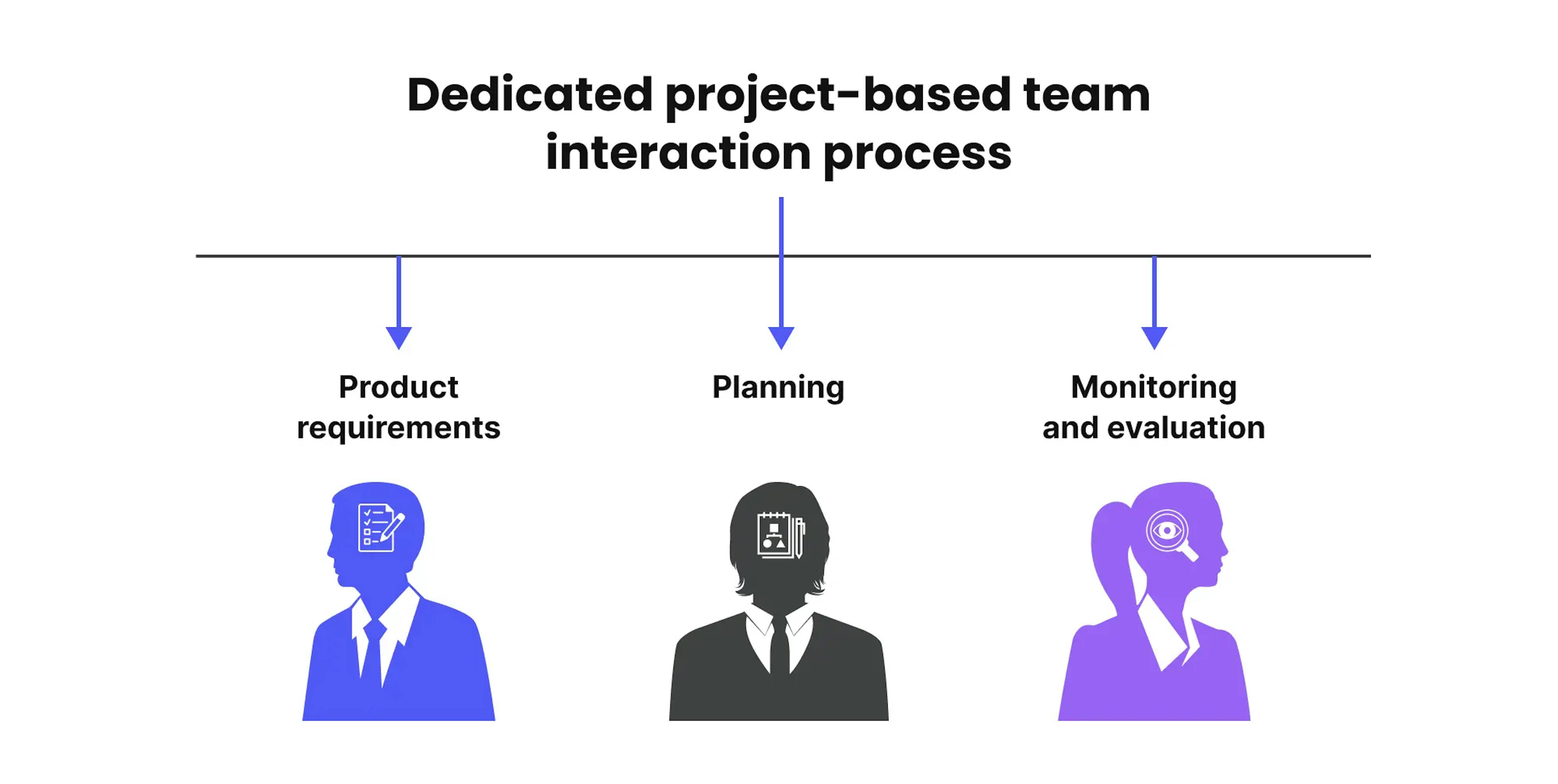There are many ways to extend the capabilities of your IT staff. And there are many ways how to call it. For example, a contractor is what they call it in the United States. Subcontracting and offshoring are popular in Europe. Australia is using talent outsourcing.
Whatever you call it, when you have more IT development needs than your staff can handle, you need help. Increasingly, companies are turning to outside vendors both at home and abroad. Most importantly, you are concerned about improving the quality of your product. And here, the important question arises "which model to use?".
This article will quickly go through outsourcing, outstaffing, insourcing, etc. Still, more importantly, we will talk about why companies are trying to move away from these models and what is coming to replace them. What is most important is to understand what transparent remote staffing is.
Why do businesses prefer outsourcing, outstaffing, and Insourcing?
For the purposes of this article, we treat the term "remote insourcing" as closely related to "outstaffing." While the concept of remote insourcing was introduced by Intetics, its similarities to outstaffing make it unnecessary to differentiate the two in this context.
Outsourcing became a recognized business strategy in 1989 and quickly became an integral part of modern business economics by the 1990s. Initially, it referred to using external resources to handle tasks traditionally performed in-house. Today, outsourcing is a well-established practice, particularly in software development, where cost efficiency and talent acquisition are crucial.
So why do companies look out for IT talent outside their own organization? The main reason is cost. When you combine outsourcing with offshoring to countries with low living costs, you can save on employee benefits and overhead costs. Also among the reasons companies outsource or outstaff their IT talent are:
- Fresh ideas. Companies have focused more on improving quality and efficiency in the past few years. Their goal is to find better and faster ways to do things.
- Deadlines. Businesses prefer outsourcing and outstaffing because they need someone who can meet deadlines and deliver on time. As a result, your company will not lose money due to missed deadlines.
- Expertise. Your company may lack specialized expertise, such as decentralized finance knowledge, which is becoming increasingly popular. Outsourcing those tasks allows you to focus on other aspects of your business while skilled professionals handle the work quickly and efficiently.
- Fast scaling. Every business wants to grow its market share, scale its operations, and increase its customer base. To accomplish this, they want to do it as quickly as possible without compromising quality.
But there is an old question regarding software development: what is better—IT outsourcing or IT outstaffing, and what is the difference? Let's highlight the main points.
Outstaffing vs. outsourcing: key differences
| OUTSTAFFING | OUTSOURCING | |
|---|---|---|
| Description | Involves hiring remote professionals who work exclusively for the client's company. These team members are essentially an extension of the client’s in-house team. | Delegates a specific project, task, or function to an external service provider who manages the entire process. |
| Management | The client directly oversees the daily tasks, priorities, and workflows of the outstaffed employees. | The external vendor assumes responsibility for project execution and delivers pre-defined outcomes, freeing the client from day-to-day oversight. |
| Use case | Ideal for businesses needing specific expertise or additional manpower to integrate into their existing processes. | Best suited for businesses looking for turnkey solutions or specialized expertise to handle non-core activities. |
| Best for | Companies looking for long-term, scalable solutions | Businesses needing temporary or specialized support |

Outstaffing vs. outsourcing: pros and cons
Each approach has its own set of advantages and challenges, making the decision highly dependent on the organization's goals, resources, and expertise. But this often raises questions like, "Is outsourcing bad?" or "Why is outsourcing good?" The reality is that the effectiveness of any model depends on how it's implemented and aligned with the company's needs. Below is a breakdown of their respective pros and cons.
Outsourcing: Pros
- Reduce costs by avoiding expenses like salaries, benefits, training, and infrastructure for in-house employees. Often, outsourcing is more affordable in regions with lower labor costs.
- Gain access to highly skilled professionals and industry experts, often equipped with advanced tools and technologies not available in-house.
- Free up internal resources to focus on strategic goals and core competencies.
- Adjust resources easily, scaling up or down based on project needs.
- Speed up delivery with experienced vendors who can execute tasks efficiently, ensuring a faster time-to-market.
- Minimize risks, as vendors often handle compliance and operational challenges as part of their service agreements.
Outsourcing: Cons
- Reduced control over processes, quality, and timelines, with potential misalignment to your company's standards and vision.
- Risk of exposing sensitive data to third parties, leading to potential confidentiality and security concerns.
- Long-term dependence on vendors can limit flexibility and control, with your outcomes closely tied to their performance.
- Collaboration challenges due to differences in time zones, language, or work culture.
- Unanticipated expenses from contract negotiations, revisions, or unforeseen challenges that add to overall costs.
Outstaffing: Pros
- Maintain full control over processes, quality, and team performance, ensuring easier alignment with company culture and objectives.
- Benefit from enhanced collaboration, as in-house teams typically communicate more effectively and adapt quickly to changes.
- Improve security by reducing risks of data breaches and intellectual property theft through in-house operations.
- Create long-term value by investing in internal capabilities and building sustainable growth and expertise.
- Achieve better cultural integration, with in-house teams naturally aligning with the company’s mission, values, and culture.
Outstaffing: Cons
- Higher expenses due to salaries, benefits, training, and infrastructure required for maintaining in-house teams.
- Limited access to specialized knowledge or tools, as internal teams may lack expertise in certain areas.
- Increased strain on resources, with employees potentially overburdened when taking on new projects, affecting overall productivity.
- Slower scalability, as expanding an in-house team involves time-consuming processes like hiring, training, and onboarding.
- Risk of inefficiency, with projects potentially delayed or yielding subpar results if the team isn't adequately equipped.
🔍 Pros and cons comparison table
| ASPECT | OUTSOURCING | OUTSTAFFING |
|---|---|---|
| Cost | Lower initial costs; potential for hidden fees. | Higher upfront costs; long-term investment. |
| Expertise | Access to specialized talent and tools. | Dependent on the internal team’s skills and resources. |
| Control | Limited; vendor-driven processes. | Full control over processes and quality. |
| Security | Higher risk due to data sharing with third parties. | Better security as tasks remain in-house. |
| Scalability | Quick scalability up or down. | Slower scalability due to hiring and training. |
| Cultural fit | May face challenges with cultural alignment. | Seamless integration with company culture and values. |
| Risk | Vendor may assume certain risks but performance dependency exists. | Risks are entirely internal, relying on team capability and resources. |
Why do companies refuse to outsource and outstaffing?
Above, we outlined the common challenges and drawbacks of outsourcing and outstaffing. Now, let's take a closer look at these issues to understand why they arise and why they can become significant concerns for businesses.
Limited control over how things are done. Outsourcing the development processes to another company means relinquishing control over them. The vendor can do things however they see fit, and often, they will not include the client in the decision-making process. You might not have any information on their methodologies and cannot make requests.
Lack of agility and customization. The lack of loyalty and ownership can result in issues with outsourcing jobs—which is a common issue when working with outsourcing teams, and it is understood that someone working on a product they do not own will not feel any loyalty or pride towards it.
Possibility of miscommunication. Be prepared to give up some benefits because the outsourcing company has a lot of clients, and they have to provide services to everyone, so working on the same project will customize and respond to changes not so quicker than an inner employee. They usually take a standardized approach to help them get the work done on time.
Difficulties with flexibility and transparency. Every team needs flexibility. Working with an outsourcing/outstaffing team, you have to communicate to promote an equal partnership for both firms. If there is a new client for an outsourced company, they may ask to replace one of the team members or pick him up. Or if you decide to make some changes to the project, you will have to call their manager and get them to change the process and quote a new price for it.
The burden of secondary costs. The secondary cost elements represent the flow of costs internally because these are created and used only in Cost accounting. Secondary costs are some of the most significant issues with outsourcing jobs, and you have to consider everything when deciding. There needs to be a short-term and long-term analysis of the project so you can avoid unforeseen costs.
The ethical dilemma. Many companies are scared of outsourcing because of ethical issues. Especially if the outsourcing agency is Indian or Chinese, these countries have a lot of human capital, and their qualified resources are available at lower costs.
The cultural dilemma. However, a language and cultural barrier may make it difficult for employees to understand each other. Do not forget that even new team members may work in different time zones.
Outsourcing is a great development model for companies that lack the technical expertise, skills, and resources to complete a project. It needs to be managed in a way that the situation stands to serve both parties. Recently, however, more and more questions have arisen about this system, and companies are looking for new ways.
Transparent remote staffing: The future of cooperation in tech companies
Transparency in the workplace is a lot like transparency outside of it. It is important for the well-being of all relationships, despite the one between employees and management. It allows managers the insight to ensure teams stay on track, the ability to communicate with them seamlessly, and the oversight to remain well-informed. The high level of transparency favorably impacts the level of trust and willingness to engage, which fosters greater collaboration in the long run.
But what is transparent remote staffing (TRS)? The term originally appeared in construction and later spread to other industries. Transparent remote staffing—is an outsourcing model that uses workers to fill any term job position within your company. The most important difference is the client fully sees all financial processes and salaries of employees, employees are de jure assigned to the customer, and de facto, the contractor can also interact with them.
Let's imagine that a company needs a team to develop a project. Сustomer orders it, but it is not responsible for the team, team members can be pulled out of the project at any time. It is as if the pilot of an aircraft did not have a standard mechanism for communicating with air traffic control.
Similarly, in a TRS relationship, each side will fulfill the requirements, depending on which side of the relationship they represent.
How transparent remote staffing meets your business needs
Previously Mad Devs as a vendor, adhered to the dedicated project-based team model. This model is optimal for the following:
- Businesses that need to raise funds quickly move to the next stage.
- Companies that plan to reorganize their internal IT departments to optimize costs and performance.
- Existing businesses need teams with specific expertise to develop new products.
- Companies that don't have expertise in hiring and supervising big tech teams.

Hiring such a team, you will prepare a product requirements document (PRD) with project stakeholders. Usually, our dedicated SWAT team prepares a product requirements document (PRD). Additionally, we create a roadmap for the product and constantly adjust its vision and priorities. Moreover, development teams welcome customers to communicate directly with each team member to effectively align with business goals and get actively involved in the product.
Not long ago, Mad Devs expanded its services range and added a transparent remote staffing model. We want to see it as providing an efficient, transparent, fully remote, and enjoyable staffing experience to companies and tech partners.
When more than 5-7 people are on the team, located in different countries, in different time zones, and start their workdays at other times, it becomes difficult to maintain transparency in the work process. To address these challenges, we introduced Enji.ai, an advanced tool designed to simplify team management and enhance process visibility. With Enji.ai, we:
- Accurately track employee hours to ensure accountability and fairness.
- Automate payroll settlements, prepare consolidated margin reports, and analyze employee-related expenses for optimal budget allocation.
- Provide stakeholders with clear and detailed reports, eliminating doubts about resource utilization.
What makes Enji.ai stand out is its focus on fostering a healthy work-life balance. By using real-time data, teams feel confident that time accounting is both fair and non-intrusive, encouraging engagement and trust.
Beyond time tracking, Enji.ai is a comprehensive productivity tool that helps teams:
- Monitor real-time workloads.
- Ensure efficient collaboration.
- Provide actionable insights to improve team performance.
Thanks to Enji.ai, our teams stay transparent, synchronized, and efficient, no matter where they are located. Stakeholders also benefit from complete visibility into processes and expenditures, building trust and ensuring smooth collaboration across the board.
A transparent remote staffing model is optimal for companies preferring a dedicated project-based team model but wants to know more. Therefore, by applying for this service, you get more benefits as:
- You will get a team that operates under your direction;
- Mad Devs take over logistics and operations, so you save time and reduce errors;
- The fear that the team may be transferred to another project disappears because the team de jure is yours.
- Adapt your team size to meet your business's needs. Mad Devs take over team management and dismisses employees at the customer's request.
- Open motivation system.
Thus, Mad Devs take on management challenges, finding new specialists and replacing specialists. The vendor and the customer become technical management partners with this cooperation model.
The customers are interested in a strong team that will close their needs with minimal complications, and we are interested in growth and long-term cooperation. As part of this model, we can provide both outsourcing and outsourcing services to the customer. We can say that transparent remote staffing is a hybrid model.
Final thoughts
It's like selling a promise when you offer app development outsourcing services. Even if the IT outsourcing company promises the moon and stars, we cannot talk about trust until the actions match the words. Therefore, you need to look for a software company that adheres to clear and transparent procedures when searching for a reliable tech partner. This way, you can have peace of mind knowing your digital project is in trustworthy hands. Consequently, it's essential to prioritize building long-term partnerships with customers rather than simply offering services.
Let us show you how transparent an IT outsourcing company can be.












